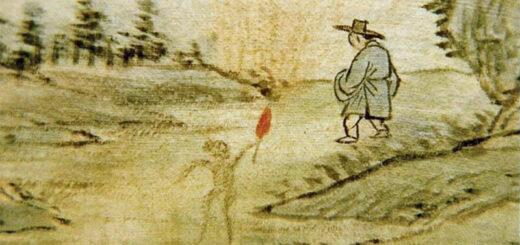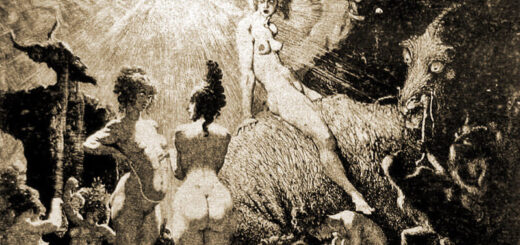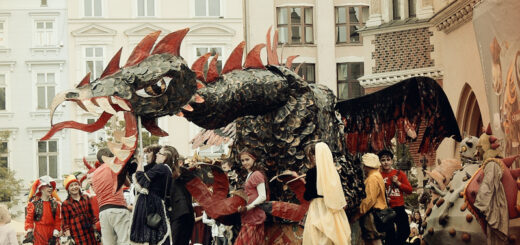The historical context surrounding the publication of the Grand Grimore by Pythagoras 38
The Grand Grimore, authored by Reuben Swinburne Clymer under the pseudonym “Pythagoras 38,” is an eclectic occult training manual intended for lodge members. (It is crucial not to confuse this work with the medieval Grand Grimoire.) This unique occult volume, published in 1910, incorporates material from various classic grimoires, magical evocation rituals, and other occult practices, such as instructions on using the planchette, imagination magic, and breathing exercises.

A member of Societas Rosicruciana in America stands in the interior of his society’s New York temple, in 1913
Notably, The Grand Grimoire holds a special place in Americana literature, as it emerged during a significant period in American history when the occult movement experienced a surge, primarily influenced by the groundwork laid by Paschal Beverly Randolph. This movement found its foothold in Masonic and new Rosicrucian organizations, shaping a new occult movement in 20th-century America.
Paschal Beverly Randolph

Paschal Beverly Randolph, the most influential figure in American occultism and Rosicrucianism
The modern Rosicrucian movement in the United States draws significant inspiration from American Freemasonry, even though it asserts its roots in mystical and alchemical texts published in seventeenth-century Germany.
In the late nineteenth-century it was Paschal Beverly Randolph (1825-1875) who stood out as the most influential Rosicrucian thinker. Despite his mixed race heritage, Randolph achieved remarkable success, garnering a significant following both in Europe and the United States.
Randolph’s Magia Sexualis for example influenced the famous Czech magician Franz Bardon. Paschal Beverly Randolph was an American medical doctor, occultist, spiritualist, trance medium, and writer, who holds a notable place in history.
He is recognized as one of the early individuals to introduce the principles of erotic alchemy to North America, and is credited by A. E. Waite with establishing the earliest known Rosicrucian order in the United States.
Born in New York City, Randolph’s background is intriguing as he was a free black man with ancestral ties to William Randolph. His mother, Flora Beverly, hailed from a diverse heritage of English, French, German, Native American, and African roots. Tragically, Randolph experienced homelessness and poverty following his mother’s early demise, prompting him to seek a livelihood at sea.
During his youth and early adulthood, Randolph’s maritime occupations allowed him to traverse vast distances, immersing himself in various cultures and encountering occultists in England and Paris. His keen interest in mysticism and the occult led him to study with local practitioners and explore different religions.
Alongside his work as a trance medium, Randolph pursued medical training and authored numerous books on topics ranging from health and sexuality to spiritualism and occultism.
Notably, he fearlessly advocated for birth control when it was largely forbidden to broach such subjects. In 1858, Randolph founded the Fraternitas Rosae Crucis, using the pseudonym “The Rosicrucian” for his spiritual and occult writings.
The organization’s first lodge was established in San Francisco in 1861, making it the oldest Rosicrucian organization in the United States.
While the Fraternitas Rosae Crucis no longer emphasizes Randolph’s interest in sex magic, his magico-sexual theories and practices heavily influenced the teachings of the Hermetic Brotherhood of Luxor, although there is uncertainty about Randolph’s personal association with the Brotherhood.
Despite working independently, Randolph’s extensive exploration of esoteric teachings solidified his identity as a Rosicrucian.
Reuben Swinburne Clymer

Reuben Swinburne Clymer wrote the Grand Grimore under the pseudonym Pythagoras 38
In 1902, R. Swinburne Clymer (1878 – 1966) from Quakertown, Pennsylvania, published an historical account of the Rosicrucian movement.
Clymer became a prominent American occultist and served from1922 untill his death in 1966 as the modern Rosicrucian Supreme Grand Master of the FRC (Fraternitas Rosae Crucis), founded by Randolph.
In the years before, he also established his own Rosicrucian Fraternity, adopting a hierarchical structure reminiscent of Freemasonry.
Within this organization, the Imperialistic Council and Venerable Order of the Magi held authority, while individuals could progress through various degrees such as Priests of Melchizedek, Knights of Chivalry, and the Order of the Holy Grail.
Clymer pursued medical studies in Chicago, eventually becoming a registered osteopath in New York in 1910.
However, his involvement in alternative medicine frequently brought him into opposition with the United States government and the American Medical Association (AMA).
Clymer operated the “International Academy of the Natural and Sacred Science” in Union City, Michigan, where a correspondence course on the “Natural System of Healing” was offered.
As an osteopath, Clymer was an outspoken opponent of vaccination and asserted that meat consumption, particularly when combined with beans, bread, potatoes, and beer, was the primary cause of cancer, immorality, and insanity.
He promoted a pescatarian diet, advocating for the exclusion of red meat, which he considered toxic.
His dietary beliefs were reflected in various publications, including The Rose Cross Aid Cook Book authored by Clara Witt and Clymer’s own work titled Diet: The Way to Health.
Throughout his life, Clymer kept an admiration for his predecessor Paschal Beverly Randolph. Clymer established his Philosophical Publishing Company in either 1900 or 1904, through which he preserved Randolph’s writings and created a hagiographic (though largely fictitious) history of him.
He attributed the foundation of his occult orders to Randolph, despite their largely unrelated origins, connecting various Hermetic Brotherhood of Light-orders in Quakertown to Randolph’s lineage.
Clymer crafted a more cohesive belief system based on Randolph’s thoughts, refining some of the problematic sex magic practices associated with Randolph and addressing his self-contradictions on numerous points.
The fictional history Clymer constructed portrayed Randolph as the legitimate heir of an ancient Rosicrucian tradition in America.
This fabrication involved connecting Randolph’s “order” to historical figures like Abraham Lincoln, Napoleon III, Alexandre Saint-Yves d’Alveydre, Papus, Albert Pike, and the Count of St. Germain, as well as to ancient Egyptian Rosicrucians, creating an elaborate pseudo-history.
Although Clymer genuinely believed his biography of Randolph to be historically accurate, it is now recognized as largely fictional.
Rosicrucian Rivalry
Clymer was passionately involved in various fields, including the esoteric arts, and authored numerous works on subjects ranging from alchemy and nutrition to religion, sex magic, and spiritualism.
However, his pursuits often resulted in conflicts with figures and institutions. Clymer’s assertion of his position as the authentic leader of American Rosicrucianism pulled him into a long-lasting conflict with Harvey Spencer Lewis, the founder of the AMORC (Ancient Mystical Order Rosae Crucis).
This rivalry escalated into bitter contention due to their contrasting beliefs regarding the role of sex in magic. Each side accused the other of promoting perverse teachings while staunchly defending their practices as enlightened and pure.
Clymer’s perspectives, heavily influenced by Randolph’s teachings, centered on the regular exchange of bodily fluids between married partners as a crucial element for the physical and spiritual well-being of each individual.
Clymer and Lewis also engaged in a competition for the recognition and affiliation of different national branches of the OTO (Ordo Templi Orientis), both achieving comparable success without gaining the upper hand to claim legitimacy over each other.
In 1934, Lewis co-founded FUDOSI (Fédération Universelle des Ordres et Sociétés Initiatiques), which acknowledged AMORC as the true heirs of American Rosicrucianism.
In response, Clymer co-founded FUDOFSI (Fédération Universelle des Ordres, Fraternités et Sociétés Initiatiques) in 1938, alongside Constant Chevillon and Jean Bricaud, supporting his FRC. Clymer denounced Lewis’s FUDOSI, considering it an unsuccessful attempt at legitimization.
The rivalry intensified, with AMORC publishing material criticizing Clymer’s ideas as “some of the weirdest notions that a human mind ever harbored” and highlighting his “self-appointed and self-devised” positions.
And it must be said that Clymer provided a lot of free ammunition for his opponent by uttering statements that were quite “unusual,” even in occult circles.
For example, he translated the famous work on incubi and succubi of Ludovico Maria Sinistrari but changed Sinistrari’s incubi and succubi to Elementals and suggested that the virgin birth of Jesus was the result of a Salamander impregnating Mary.
Clymer retaliated by raising suspicions about Lewis’s doctorate, accusing him of promoting inauthentic works and practicing black magic due to his association with Aleister Crowley.
Crowley initially offered to assist Lewis in countering Clymer’s attacks, but their later dispute over control of AMORC led to a rift between them. This intense American rivalry eventually reverberated in European Rosicrucianism, creating divisions within the community.
In 1914, a resurgence of interest in Rosicrucianism occurred during the tercentenary celebration of the original Rosicrucian manifesto.
Subsequently, in 1915, H. Spencer Lewis founded the Ancient Mystical Order Rosae Crucis (AMORC), which drew inspiration from Theosophy and the Golden Dawn. Initially established in New York, Lewis later embraced the prevailing trend of esoteric groups moving westward, eventually making California the global hub of the New Age movement.
By 1918, he had relocated to San Francisco, and in 1927, the world headquarters for AMORC was established in San Jose. This transformative period significantly reshaped America’s spiritual landscape, ushering in the era of the First New Age.
Fraternitas Rosae Crucis

Rosicrucian symbolism
Meanwhile, the Fraternitas Rosae Crucis (Fraternity of the Rosy Cross or FRC) stands as the oldest Rosicrucian Order in the United States, founded by Paschal Beverly Randolph in 1856.
As a fraternal organization, it operates the Beverly Hall Corporation and the Clymer Health Center in Quakertown, Pennsylvania. The FRC’s history traces back to 1861 when its first lodge was established in San Francisco, though it closed shortly after.
In 1871, another lodge was founded in Boston, followed by a reestablishment in San Francisco in 1874. Finally, in 1875, the FRC settled in Philadelphia. Under the leadership of Reuben Swinburne Clymer, the FRC found its permanent home at Beverly Hall in Quakertown, Pennsylvania.
Throughout its existence, the FRC has been guided by a series of Supreme Grand Masters, each playing a crucial role in shaping the FRC’s path and ensuring its enduring continuity over the years.These include:
- Paschal Beverly Randolph (1858–1875)
- Freeman Benjamin Dowd (1875–1907)
- Edward Holmes Brown (1907–1922)
- Reuben Swinburne Clymer (1922–1966)
- Emerson Myron Clymer (1966–1983)
- Gerald Eugene Poesnecker (1983–2003)
- William Glen Kracht (2003–present)

Grand Grimore content detail
Books by R. Swinburne Clymer:
1. The Thomsonian System of Medicine: With Complete Rules for the Treatment of Disease: Also a Short Materia Medica (Philosophical Pub. Co., 1905)
2. True Spiritualism (The Philosophical Publishing Company, 1906)
3. The Philosophy of Fire (The Philosophical Publishing Co., 1907)
4. Christhood and Adeptship (The Philosophical Publishing Co., 1910)
5. The Grand Grimore (The Philosophical Publishing Co., 1910 – under pseudonym “Pythagoras 38”)
6. The Rosicrucians, their teachings and mysteries according to the manifestoes issued at various times by the fraternity itself. Also, some of their secret teachings and the mystery of the order explained... (The Philosophical Pub. Co., 1910)
7. International Esoteric and Illuminated Bible Lessons (The Philosophical Publishing Co., 1911)
8. The Illuminated Faith: Mystical Interpretation of the Gospel of St. John, in Harmony with Higher Soul Culture and in Accordance with the New Revelation (Philosophical Publishing Co., 1913)
9. The Way to Life and Immortality; A Positive Philosophy Leading Man Away From “Sin”… and to Manhood, Successful Achievement, Godliness and Immortality (The Philosophical Publishing Co., 1914)
10. The Way to Godhood: Second Textbook on the New Life That Shall Lead Man From Weakness, Disease, and Death, to Freedom From These Things, and to Strength and Power Before Unknown (Allentown, PA: Philosophical Pub. Co., ca. 1914)
11. The Divine Spark, and The Great Pyramid, a Temple of Initiation (Printed by the Philosophical Publishing Co., 1914)
12. The Æth Mystery (The Philosophical Publishing Co., 1914)
13. Making Health Certain; a Philosophical and Inspirational Treatise on the Establishment and Maintenance of Health Through a Constructive Mental Attitude (The Humanitarian Society, 1921)
14. Mastership, the Divine Law (Philosophical Pub. Co., 1922)
15. The Book of Rosicruciae; a condensed history of the Fraternitas Rosae Crucis or Rosy Cross, the men who made the order possible, and those who maintained the fraternity throughout the centuries, together with the fundamental teachings of these men according to the actual records in the archives of the fraternity. Issued by La Fédération universelle des ordres, sociétés et fraternités des initiés. (Philosophical Pub. Co., 1946)
16. The Mystery of Sex and Race Regeneration: A Sane, Sensible and Reasonable Approach to the Highly Important But Much Involved Problem of Sex From The Natural, Moral and Religious Aspects and Having the Regeneration of the Race in View (fourth edition; Quakertown, PA: Philosophical Pub. Co., 1950)
17. The Mysteries of Osiris; or, Ancient Egyptian Initiation. Setting Forth the Symbolism, Mythology, Legends, and Parables Beginning with the Outer Religious Systems of the Egyptians, Primarily Based on the Drama of the Heavens; Together with the Inner or Esoteric Interpretations as Taught in the Lesser and Greater Mysteries Active Throughout the Ages, Including the Present. [Completely Rev.] (Philosophical Pub. Co., 1951)
18. The Interpretation of St. John: An Exposition of the Divine Drama; The Nazarene’s Life, and What It Teaches to Man (Philosophical Pub. Co., 1953)
19. Your Health, Your Sanity in the Age of Treason: Food and Liquids Used as a Medium in Deliberately and Carefully Planned Methods Developed by the Vicious Element of Humanity, for the Mental Deterioration and Moral Debasement of the Mass, as a Means Toward Their Enslavement (Quakertown, PA: Humanitarian Society, c1958)
20. The Age of Treason (Humanitarian Society, 1959)
21. Nature’s Healing Agents: The Medicines of Nature (or the Natura System) (Philadelphia: Dorrance and Co., c1963)
22. Alchemy and the Alchemists (AMS Press, 1982)
You may also like to read:
The anatomy of the human being in the kabbalah
Shades of Death Road, Warren County, New Jersey
Jewish magic or Kabbalah Ma’asit (Practical Kabbalah)






